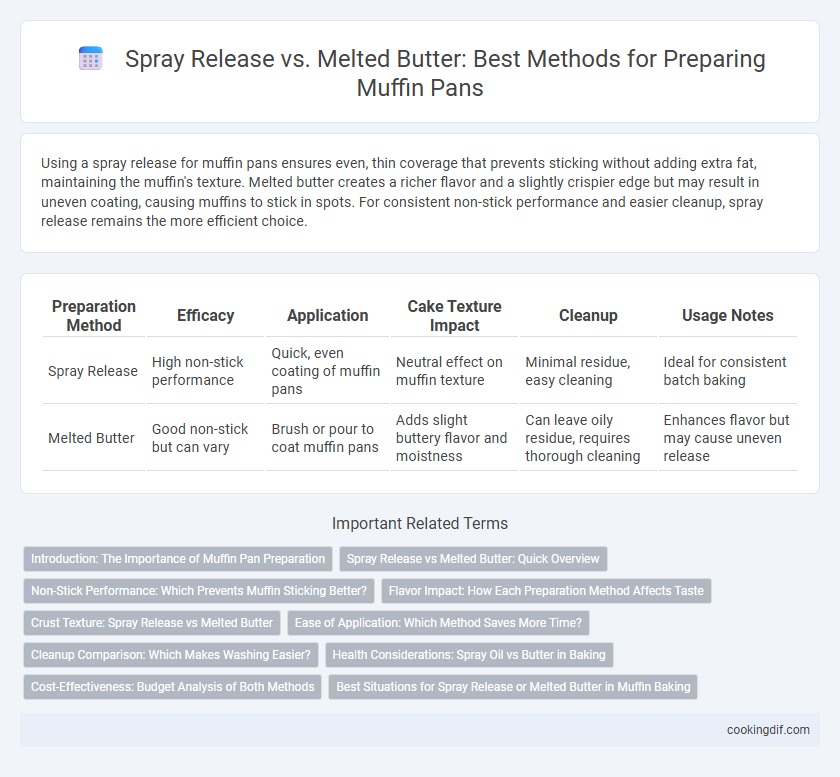Using a spray release for muffin pans ensures even, thin coverage that prevents sticking without adding extra fat, maintaining the muffin's texture. Melted butter creates a richer flavor and a slightly crispier edge but may result in uneven coating, causing muffins to stick in spots. For consistent non-stick performance and easier cleanup, spray release remains the more efficient choice.
Table of Comparison
| Preparation Method | Efficacy | Application | Cake Texture Impact | Cleanup | Usage Notes |
|---|---|---|---|---|---|
| Spray Release | High non-stick performance | Quick, even coating of muffin pans | Neutral effect on muffin texture | Minimal residue, easy cleaning | Ideal for consistent batch baking |
| Melted Butter | Good non-stick but can vary | Brush or pour to coat muffin pans | Adds slight buttery flavor and moistness | Can leave oily residue, requires thorough cleaning | Enhances flavor but may cause uneven release |
Introduction: The Importance of Muffin Pan Preparation
Proper muffin pan preparation using spray release or melted butter significantly impacts muffin texture and ease of removal. Spray release ensures an even, non-stick coating that minimizes batter absorption and maintains muffin shape, while melted butter adds flavor and creates a slightly crisp edge but may cause uneven sticking if not applied uniformly. Selecting the right preparation method enhances baking consistency and improves muffin aesthetics.
Spray Release vs Melted Butter: Quick Overview
Spray release offers a convenient, even coating that prevents muffin batter from sticking, ensuring easy removal and minimal mess. Melted butter adds rich flavor and helps create a slightly crisp, golden crust but may require more careful application to avoid uneven baking. Choosing spray release emphasizes speed and cleanliness, while melted butter enhances taste and texture in muffin preparation.
Non-Stick Performance: Which Prevents Muffin Sticking Better?
Spray release products often provide a thin, even coating that enhances non-stick performance by creating a barrier between the muffin batter and the pan surface, reducing sticking effectively. Melted butter, while adding flavor and moisture, can sometimes pool unevenly, leading to inconsistent non-stick protection and increased chances of muffin sticking. Non-stick sprays specifically formulated for baking typically outperform melted butter in preventing muffins from sticking to pans, ensuring easy release and maintaining muffin integrity.
Flavor Impact: How Each Preparation Method Affects Taste
Spray release creates a light, neutral coating that preserves the muffin's original flavor without adding any additional taste. Melted butter imparts a rich, buttery aroma and slightly enhances the muffin's crust, contributing a deeper flavor profile. Using melted butter often results in a more indulgent and savory finish compared to the subtle effect of spray release.
Crust Texture: Spray Release vs Melted Butter
Spray release creates a thin, even non-stick coating that helps muffins release cleanly while maintaining a softer, more tender crust texture. Melted butter adds richness and promotes browning, resulting in a slightly thicker, crisper crust with enhanced flavor complexity. Choosing between spray release and melted butter impacts muffin pan preparation by balancing ease of removal against desired crust crispness and mouthfeel.
Ease of Application: Which Method Saves More Time?
Using spray release for muffin pan preparation significantly reduces application time due to its quick, even coating and minimal cleanup. Melted butter requires more effort to evenly brush each cup, increasing preparation time and the risk of uneven non-stick coverage. Spray release is the more efficient option for bakers seeking speed without compromising muffin pan performance.
Cleanup Comparison: Which Makes Washing Easier?
Spray release creates a thin, even non-stick layer on the muffin pan, significantly reducing residue buildup and making cleanup faster and easier. Melted butter tends to leave greasy, sticky spots that can require scrubbing and more time to wash off thoroughly. Overall, spray release minimizes post-baking cleanup by preventing stubborn food particles from adhering to the pan's surface.
Health Considerations: Spray Oil vs Butter in Baking
Using a spray oil for muffin pan preparation typically reduces calorie and fat intake compared to melted butter, which contains saturated fats linked to cardiovascular risks. Spray oils often use vegetable oils rich in unsaturated fats, promoting heart health by lowering LDL cholesterol levels. Choosing spray release over melted butter can help create healthier baked goods without compromising non-stick performance.
Cost-Effectiveness: Budget Analysis of Both Methods
Spray release offers a cost-effective option by minimizing the amount of product used per muffin pan, reducing overall expenditure in large-scale baking operations. Melted butter, while enhancing flavor and texture, tends to increase costs due to higher quantities required and potential wastage from uneven application. Budget analysis reveals that spray release is generally more efficient for high-volume use, whereas melted butter may be a preferred choice for premium, small-batch baking despite its elevated cost.
Best Situations for Spray Release or Melted Butter in Muffin Baking
Spray release provides an even, non-stick coating ideal for large batch muffin baking or delicate batters prone to sticking, ensuring quick release without altering the flavor. Melted butter offers a richer taste and slightly crispier edges, best suited for home baking or recipes where a buttery crust enhances the muffin's texture and flavor profile. Choosing spray release is optimal for efficiency and consistency, while melted butter suits artisanal or small-batch muffins emphasizing flavor and mouthfeel.
Spray release vs Melted butter for muffin pan preparation Infographic

 cookingdif.com
cookingdif.com